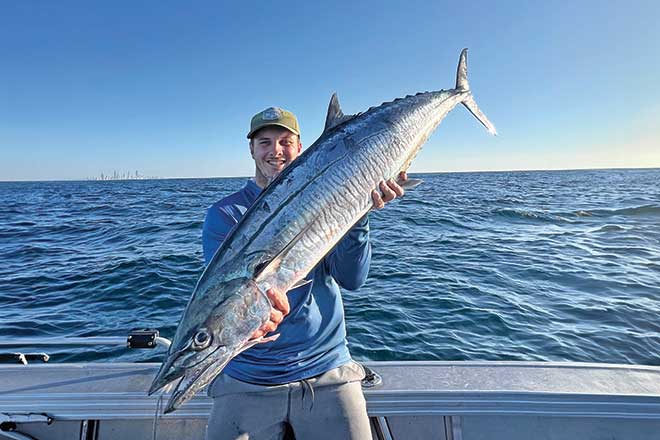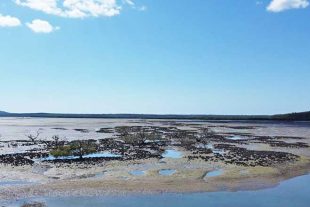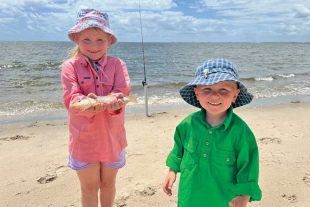Live baiting spanish mackerel can be the answer to either an amazing session or a slow morning.
This all depends on the season, the water and various other conditions.
The better times I’ve found for live baiting in winter have always been the start and the end, with dead bait filling in the middle.
From big yakka and bonito to slimies and even tailor – these have all been great live bait for mackerel.
Towing, drifting and sitting at anchor are the best ways to use your live bait.
Offering a very simple rig that includes a 60lb multistrand wire, a single J-hook or live bait hook and a stinger/treble.
The single hook placed snuggly through the nose of your live bait and the stinger going into the middle section will give you the best results for hook-ups.
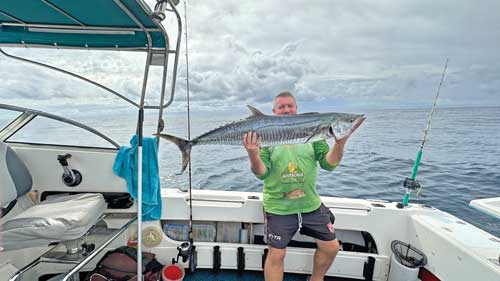
When towing your live bait, you only need to be idling in gear.
Any faster and you run the risk of killing your bait.
Keep in mind, if you’re towing against the current, you may have to go in and out of gear or make your way out of the current to continue your loop.
Once you have your live bait – which you can get from various locations, including small reef structure from 5-20m of water or even from deeper water of about 40m – you can head to your local reef.
Off the Seaway is the 24-fathom reef, which is a great place to start.
Every season, huge numbers of spanish school up the bait and have a feeding frenzy, giving many fishos a great opportunity to get stuck in.
From there you can make your way to Diamond Reef and even the 36-fathom reef.
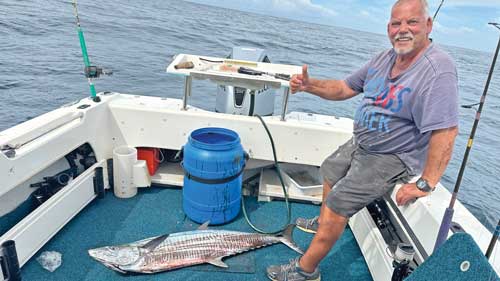
Having one live bait on top and another on a down rigger will give you the best chance to land your bag limit of spaniards for the day.
If you are fishing Tweed, there are a few reefs off the coastline that offer incredible fishing for spanish mackerel, wahoo and tuna.
These include Fidos, 5 Mile, Nine Mile and even Kingscliff Reef.
The easiest way to fish these reefs is by doing circular laps from one edge to the other, this gives you the best chance of covering ground.
And, once you’ve found the fish on your sounder, go over them from different angles – I’ve found this can be the difference between a bite or not.
An awesome way to target spanish mackerel is by sitting at anchor and having your bait sit under a balloon behind the boat in the current – the more current the better.
Give your bait enough line under the balloon so it can swim freely, and ensure it sits far enough away from the balloon that it doesn’t spook the mackerel.

Don’t worry, the current will keep your bait at the surface, so it won’t have a chance to swim down.
You can anchor anywhere from 15-30m of water safely.
Any shallower and you run the risk of the pressure from the current causing a wave that can be devastating, as seen off Tweed Heads on the local reefs.
Running 30lb monofilament both towing and anchoring has given me the better results for these fish, with enough grunt to pull the fish away from sharks.
One last thing, when you’re towing bait and you get a hit, leave the other rod out and the motor in gear.
Nine times out of 10, the other bait will get hit, resulting in a double hook-up.
I hope this has given you a better understanding of live baiting for spanish mackerel, and there’s still time to get out there and among them.
Tight lines!
 Bush ‘n Beach Fishing Magazine Location reports & tips for fishing, boating, camping, kayaking, 4WDing in Queensland and Northern NSW
Bush ‘n Beach Fishing Magazine Location reports & tips for fishing, boating, camping, kayaking, 4WDing in Queensland and Northern NSW

